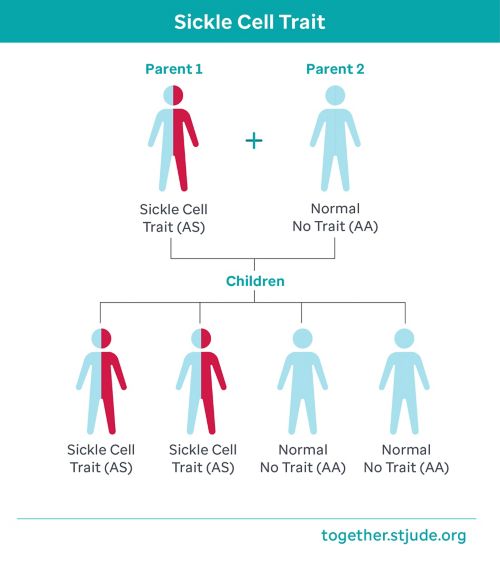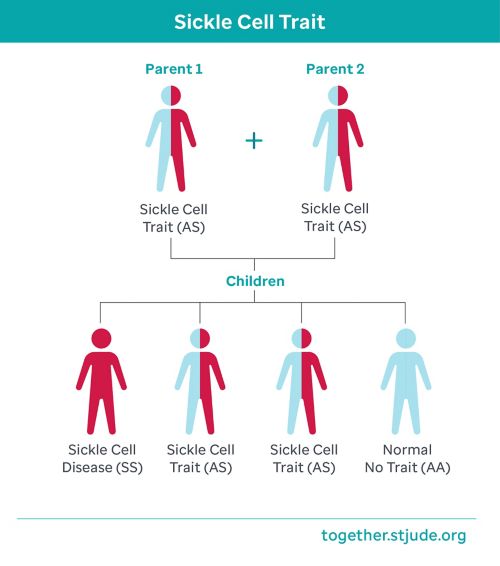What is sickle cell trait?
Sickle cell trait is a change (mutation) in a gene that affects the hemoglobin in red blood cells. All red blood cells contain hemoglobin. Hemoglobin is a protein that carries oxygen from the lungs to all parts of the body.
People with sickle cell trait have inherited an abnormal gene (hemoglobin S) from one parent and a normal gene (hemoglobin A) from the other parent. The trait does not usually cause health problems.
A trait is different from a disease
People with sickle cell trait do not have sickle cell disease. They cannot develop sickle cell disease later in life. But they can pass the genes for sickle cell disease on to their children.
People with sickle cell trait have both normal hemoglobin A and abnormal hemoglobin S in their red blood cells. Most people with sickle cell trait have no signs or symptoms of illness. The trait can sometimes cause anemia.
Health problems due to sickle cell trait are more likely under certain conditions:
- Dehydration or a lack of water in the body
- Intense exercise or physical activity that causes your body to use more oxygen
- High altitudes where there is a lack of oxygen in the air
What is sickle cell disease?
Sickle cell disease is an inherited blood disorder that affects red blood cells. Normal red blood cells are round and flexible. People with sickle cell disease have red blood cells that are hard, sticky, and shaped like a banana.
Certain genes control how the body makes hemoglobin.
- Healthy red blood cells have normal hemoglobin A.
- Sickled red blood cells have abnormal hemoglobin S.
To be born with sickle cell disease, children must inherit 2 sickle cell genes: 1 from their mother and 1 from their father. This causes red blood cells to contain mostly hemoglobin S.
Hemoglobin S causes blood cells to become sticky and banana shaped. Sickle cells clump together and clog blood vessels. This can cause problems throughout the body.
Learn more about sickle cell disease
Risk factors for sickle cell trait
A person of any race or nationality can have sickle cell trait. Sickle cell trait is more common among African Americans or people of African ancestry. In the United States, about one 1 in 13 Black or African American babies are born with sickle cell trait. It also affects people whose ancestors came from Latin America, Asia, India, and the Mediterranean region.
Tests for sickle cell trait
A blood test can determine if you have sickle cell trait. All newborn babies in the United States are tested for sickle cell trait and sickle cell disease. Blood tests may be done as part of genetic testing. Your doctor may also recommend the test if someone in your family has sickle cell disease.
How sickle cell trait is inherited
Sickle cell trait runs in families. Like hair or eye color, the genes for sickle cell trait are inherited, or passed from parents to children. Parents who have sickle cell trait can have a child with sickle cell trait or sickle cell disease.
Whether a child has the disease depends on genes from both parents. This is why it is important to understand how sickle cell trait is passed on and how it can affect the health of your children and grandchildren.
If one parent has sickle cell trait and the other parent has normal hemoglobin:
With each pregnancy there is a 50% (1 in 2) chance of having a child with sickle cell trait.
If both parents have sickle cell trait or if one parent has sickle cell trait and the other has a trait for abnormal hemoglobin:
With each pregnancy, there is a 50% (1 in 2) chance of having a child with sickle cell trait. There is also a 25% (1 in 4) chance of having a child with a sickle cell disease. Sickle cell disease is a lifelong illness that can result in serious health problems.
These are the possible outcomes with each pregnancy:
- 50% (1 in 2) chance of having a child with sickle cell trait
- 25% (1 in 4) chance of having a child without sickle cell trait and without a sickle cell disease
- 25% (1 in 4) chance of having a child with a sickle cell disease
These outcomes may also occur if one parent has sickle cell trait and the other parent has an abnormal hemoglobin trait such as beta thalassemia, hemoglobin C, or hemoglobin E.
To learn more about traits and genetic conditions, talk to your doctor or genetic counselor. Your care team can give you more details about your trait status and that of your child.





